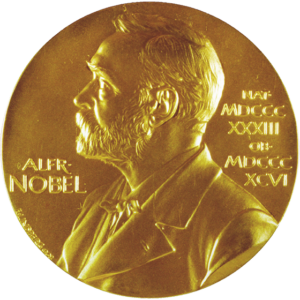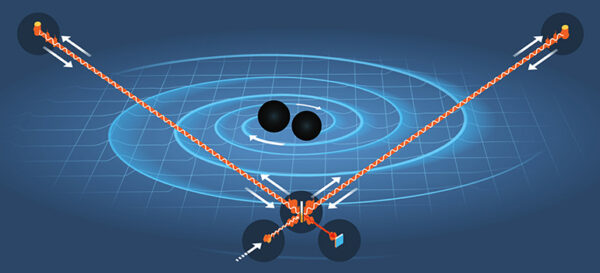The Royal Swedish Academy of Sciences has decided to award the Nobel Prize in Physics 2017 with one half to Rainer Weiss, LIGO/VIRGO Collaboration and the other half jointly to Barry C. Barish, LIGO/VIRGO Collaboration and Kip S. Thorne, LIGO/VIRGO Collaboration
“for decisive contributions to the LIGO detector and the observation of gravitational waves”
Gravitational waves finally captured
 On 14 September 2015, the universe’s gravitational waves were observed for the very first time. The waves, which were predicted by Albert Einstein a hundred years ago, came from a collision between two black holes. It took 1.3 billion years for the waves to arrive at the LIGO detector in the USA.
On 14 September 2015, the universe’s gravitational waves were observed for the very first time. The waves, which were predicted by Albert Einstein a hundred years ago, came from a collision between two black holes. It took 1.3 billion years for the waves to arrive at the LIGO detector in the USA.
The signal was extremely weak when it reached Earth, but is already promising a revolution in astrophysics. Gravitational waves are an entirely new way of observing the most violent events in space and testing the limits of our knowledge.
LIGO, the Laser Interferometer Gravitational-Wave Observatory, is a collaborative project with over one thousand researchers from more than twenty countries. Together, they have realised a vision that is almost fifty years old. The 2017 Nobel Laureates have, with their enthusiasm and determination, each been invaluable to the success of LIGO. Pioneers Rainer Weiss and Kip S. Thorne, together with Barry C. Barish, the scientist and leader who brought the project to completion, ensured that four decades of effort led to gravitational waves finally being observed.
In the mid-1970s, Rainer Weiss had already analysed possible sources of background noise that would disturb measurements, and had also designed a detector, a laser-based interferometer, which would overcome this noise. Early on, both Kip Thorne and Rainer Weiss were firmly convinced that gravitational waves could be detected and bring about a revolution in our knowledge of the universe.
Gravitational waves spread at the speed of light, filling the universe, as Albert Einstein described in his general theory of relativity. They are always created when a mass accelerates, like when an ice-skater pirouettes or a pair of black holes rotate around each other. Einstein was convinced it would never be possible to measure them. The LIGO project’s achievement was using a pair of gigantic laser interferometers to measure a change thousands of times smaller than an atomic nucleus, as the gravitational wave passed the Earth.
So far all sorts of electromagnetic radiation and particles, such as cosmic rays or neutrinos, have been used to explore the universe. However, gravitational waves are direct testimony to disruptions in spacetime itself. This is something completely new and different, opening up unseen worlds. A wealth of discoveries awaits those who succeed in capturing the waves and interpreting their message.

Rainer Weiss, born 1932 in Berlin, Germany. Ph.D. 1962 from Massachusetts Institute of Technology, MIT, Cambridge, MA, USA. Professor of Physics, Massachusetts Institute of Technology, MIT, Cambridge, MA, USA.
Barry C. Barish, born 1936 in Omaha, NE, USA. Ph.D. 1962 from University of California, Berkeley, CA, USA. Linde Professor of Physics, California Institute of Technology, Pasadena, CA, USA.
Kip S. Thorne, born 1940 in Logan, UT, USA. Ph.D. 1965 from Princeton University, NJ, USA. Feynman Professor of Theoretical Physics, California Institute of Technology, Pasadena, CA, USA.
Prize amount: 9 million Swedish krona.
The Royal Swedish Academy of Sciences, founded in 1739, is an independent organisation whose overall objective is to promote the sciences and strengthen their influence in society. The Academy takes special responsibility for the natural sciences and mathematics, but endeavours to promote the exchange of ideas between various disciplines.
Nobel Prize® and the Nobel Prize® medal design mark are registered trademarks of the Nobel Foundation.
Documents
Illustration: Gravitational waves
Illustration: Two black holes collide
Illustration: LIGO – a gigantic interferometer
Contact
Press contact
Jessica Balksjö Nannini, Press officer, The Royal Swedish Academy of Sciences
jessica.balksjo@kva.se, +46 8 673 95 44, +46 70 673 96 50
Experts
Olga Botner, member of the Nobel Committee for Physics, The Royal Swedish Academy of Sciences
olga.botner@physics.uu.se, +46 73 390 86 50
Ulf Danielsson, member of the Nobel Committee for Physics, The Royal Swedish Academy of Sciences
ulf.danielsson@physics.uu.se, +46 70 314 10 86
More information
The Laureates
Rainer Weiss, Massachusetts Institute of Technology, MIT, Cambridge, MA, USA
Barry C. Barish, California Institute of Technology, Pasadena, CA, USA
Kip S. Thorne, California Institute of Technology, Pasadena, CA, USA
LIGO websites
http://www.advancedligo.mit.edu
Books
Collins, H. (2017) Gravity’s Kiss: The Detection of Gravitational Waves, MIT Press.
Bartusiak, M. (2017) Einstein’s Unfinished Symphony: The Story of a Gamble, Two Black Holes, and a New Age of Astronomy, Yale University Press
Levin, J. (2016) Black Hole Blues and Other Songs from Outer Space. Knopf
Kennefick, D. (2007) Traveling at the Speed of Thought: Einstein and the Quest for Gravitational Waves. Princeton University Press
Collins, H. (2004) Gravity’s Shadow: The Search for Gravitational Waves. University of Chicago Press.
Thorne, K. S. (1994) Black Holes and Time Warps: Einstein’s Outrageous Legacy. W. W. Norton & Company
Videos
Hear the chirp/the sound of two black holes colliding
Thorne, K. S. (2016, 25 May) Disturbed Kerr Black Holes. The Royal Swedish Academy of Sciences
LIGO Generations (2015) Kai Staats
LIGO, a passion for understanding (2014) Kai Staats
Scientific article
Abbott, B. P. et al (2016) Observation of Gravitational Waves from a Binary Black Hole Merger, Physical Review Letters, vol. 116, 061102